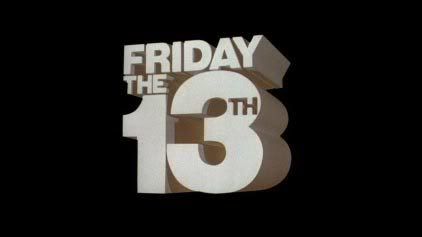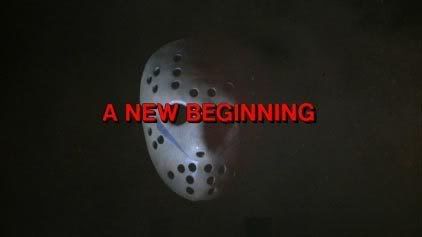Okay folks, it’s trivia time!
In which Friday the 13th movie was the killer not named Voorhees?
Now, I suspect many of you know enough about the series to remember that the franchise’s most famous maniac, Jason Voorhees, didn’t actually start killing folks until the second movie, since it was his mother Mrs. Voorhees who did all the stabbing, slicing and mutilating in the first film, but what you might not recall is that there was a movie in the middle of the series that featured a completely different maniac behind the infamous hockey mask.
Yes, it’s the Friday the 13th so bad that it was immediately stricken from the series’ already amusingly inconsistent canon and left to forever rot in slasher movie obscurity.
I am, of course, referring to:
In which Friday the 13th movie was the killer not named Voorhees?
Now, I suspect many of you know enough about the series to remember that the franchise’s most famous maniac, Jason Voorhees, didn’t actually start killing folks until the second movie, since it was his mother Mrs. Voorhees who did all the stabbing, slicing and mutilating in the first film, but what you might not recall is that there was a movie in the middle of the series that featured a completely different maniac behind the infamous hockey mask.
Yes, it’s the Friday the 13th so bad that it was immediately stricken from the series’ already amusingly inconsistent canon and left to forever rot in slasher movie obscurity.
I am, of course, referring to:
Y'know, I'm almost tempted to feel sorry for this little movie that couldn't. One only has to look at how it is represented in the From Crystal Lake to Manhattan: Ultimate Edition DVD Collection (which contains all 8 of the Paramount-produced movies in the franchise) to recognize it's status as the series' severely deformed/retarded bastard half-brother who everyone knows is kept locked away in the house's attic, but who is never, ever talked about. Of the 8 films, it easily has the worst transfer (filled as it is with noticeable scratches and other visual detritus usually not seen on a DVD from a major studio) and its chapter in the feature-length documentary about the franchise included on the last disk of the boxed set limits itself to an interview with Corey Feldman, who describes the uncomfortable day he spent filming his dream sequence cameo during a break away from the set of The Goonies. One gets the sense that had Feldman not agreed to be interviewed about his much larger role in Friday the 13th Part IV: The Final Chapter, then Part V (as it only came to be referred to when it was released to video) wouldn't have gotten included in the overview at all, since it's director, writers and main castmembers were all apparently too embarrased to come in and reminisce about their experience working on the project. Considering the quality of some films that folks are only too happy to reminisce about (including a few others in the Friday the 13th boxed set), that's pretty damning evidence of how low A New Beginning has fallen since it was released in 1985.
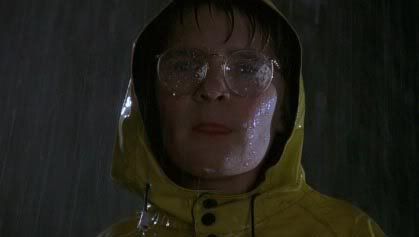
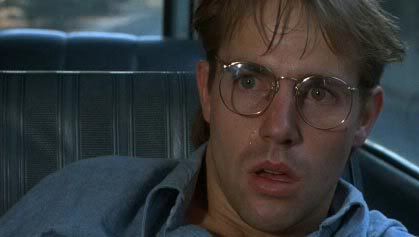
But unfortunately for the film any temptation to take pity on it for its lamentable status in the Friday the 13th pantheon evaporates as soon as you begin watching it. The film is so overtly contrived, so incompetently put together, that it plays as an unconscious self-parody of itself and the genre as a whole. Now many slasher movies attempt to distance themself from the sorid reputation of their predecessors by adding a touch of self-deprecation or winking satire along with the necessary gory set pieces and gratuitous exposure of female flesh, but in A New Beginning these comedic moments come about as the result of imcompetence rather than design. It is a film that inspires rather than invokes parody--the perfect failure that has to exist so that people can appreciate the joke when it is told by other filmmakers.
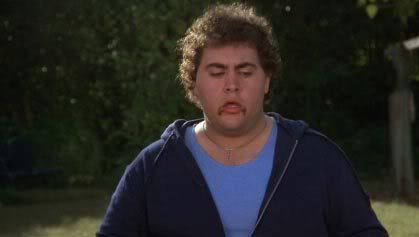
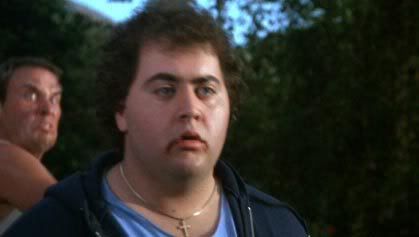
Truthfully, though, the same criticism also applies to the series' third entry, which for all of its three-dimensional gimmickry is just as contrived and idiotic as the fifth, but still remains beloved in the minds and hearts of horror movie fans everywhere. On a statistical level this seems odd if only because A New Beginning nearly doubles Part 3's bodycount and features far more memorable instances of nakedity, but on an intellectual level it makes sense because with the third film the franchise gelled into exactly what the audience wanted it to be. This is why so many people favour The Final Chapter, the fourth and decidedly unfinal movie in the series (which was directed by the man responsible for the first entry in my Sunday Horror Movie Index), as their personal favourite, because it fully capitalized on the tropes established in the third film; most importantly the use of the goalie mask, an iconic image that endures to this day.
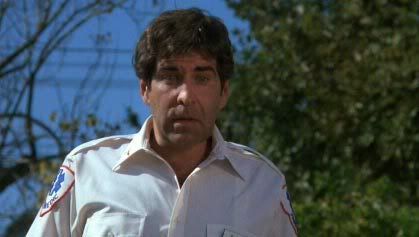

For all of its many, many flaws, the reason A New Beginning remains the Rosemary Kennedy of the Friday the 13th franchise isn't because it's awful, but because in attempting to restart the franchise, it changes the rules of the series and attempts to be something the series ceased to be after the first film--a mystery. Rather than being about a group of stupid teenagers who are slaughtered by a maniac named Jason Voorhees, it's about a group of stupid teenagers who are slaughtered by a maniac pretending to be Jason Voorhees and the difference is crucial. It's like paying to see the new James Bond movie and discovering that it's actually about some dork named Joey Bondo, who likes to dress in tuxedos and drive fancy cars, but who isn't actually a member of the British secret service. As important as the hockey mask was to the franchise, A New Beginning proved that the mongoloid zombie behind the mask meant just as much. You can't have one without the other.

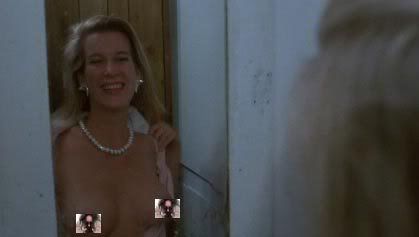
Even though it was only made a year after the fourth film, A New Beginning is actually set at least six years after the events in The Final Chapter. We know this because following the opening dream sequence in which Corey Feldman returns to watch as two nitwits dig up the presumably vanquished Voorhees grave (where the masked maniac has been logically buried with both a machete and ice pick in his hands), we see that his character, Tommy Jarvis, is now a disturbed young man who we're supposed to believe is 17 or 18, even though he looks like he's in his mid to late twenties. Interestingly enough, the movie posits the then-future of 1991 to be remarkably like that of 1985, with nary a Gameboy or Compact Disk in sight and portrays it's requisite "rebellious punk" teenage girl as a New Wave throwback, rather than as a Grunge-loving plaid-clad contemporary. In fact, it doesn't seem like it's set in the future at all, which suggests that maybe Tommy's previous experience battling Jason has not only screwed him up mentally, but also somehow managed to fuck up his natural aging process as well.

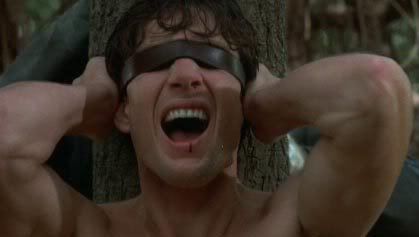
Whatever the case, when Tommy awakes from his nightmare he is in the process of being transported from the mental hospital he has been living in ever since he "killed" Jason over to the Pinehurst Youth Development Center, where it is hoped that he can be taught how to re-enter the real world and become a contributing member of society. Pinehurst seems to be quite the small-time operation, since its entire staff appears to be made up of two counselors, the blond hottie Pam and the handsome do-gooder Matthew, and Gramps, the black cook and custodian whose main job is to supply the grandson who serves as the movie's de rigueur pre-teen character (which has always struck me as an odd requirement for a series whose nudity and violence kept away the part of the audience who was presumably supposed to identify with this character--at least during its original theatrical showings that is). Of course, you don't need that many employees when you only have eight troubled teens to take care off.

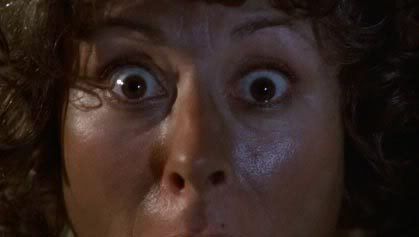
It soon becomes apparent that at least one of the eight teens is more troubled than the others when he decides to put an end to the fat kid's non-stop chatter by planting an ax in the dude's back (but you know tubby had it coming since he was such a pig he couldn't even be bothered to wipe the chocolate off of his face). But before the kids and counselors can deal with this tragedy, more murders start taking place on and around the rural-based center. Has Jason returned? Has Tommy truely lost his mind and started acting out the crimes of his past tormentor? Or is there a much more stupid and contrived reason for the killings that vaguely resembles the motivation for the murders in the very first Friday the 13th, back when Mama Voorhees was the culprit? Take a good guess.
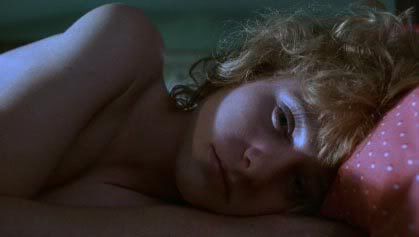
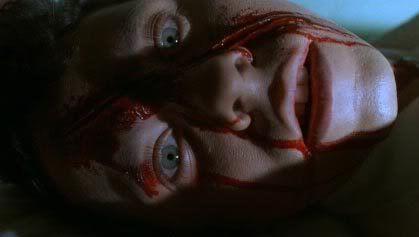
Among the absurd victims illogically (given the identity and apparent motivation of the film's real killer) butchered along the way we have two foul-mouthed juvenile delinquints who are hilariously outfitted in the kind of gay leather-daddy outfits that you last saw worn by the bearded member of The Village People, the broadest hillbilly stereotypes you never saw on The Beverly Hillbillies and a group of kids whose established personalities don't extend beyond stuttering boy, horny guy, slutty girl, punky brat and girl who just sleeps in her tiny panties.
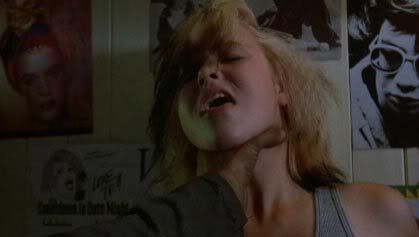

Following the revelation of the true killer's identity (note: it's the guy who gets far more attention from the screenplay than his character would normally deserve), the film attempts to justify it's title with a denoument that suggests that the experience has left Tommy even more disturbed than he was before, causing him to don the hockey mask he inexplicably finds in a drawer in his hospital room and become the "new" Jason--the film freezing just as he is about to plunge a knife into the back of the unsuspecting Pam.
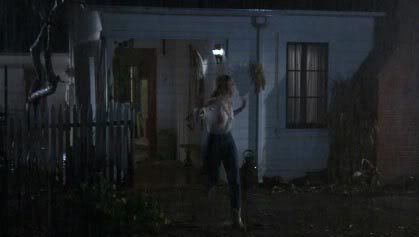

Obviously, this did not take. Tommy did return in the next film, Jason Lives, but as the hero rather than the psychopathic killer. Knowing what (and more importantly, who) the audience wanted to see, the filmmakers resurrected the dead Jason Voorhees and made him the unstoppable zombie killing machine we all know and love today. As a result that sequel is remembered fondly to this day, while its most immediate predecessor remains nothing more than a trivia question even the geekiest of horror fans would be hard-pressed to get right.
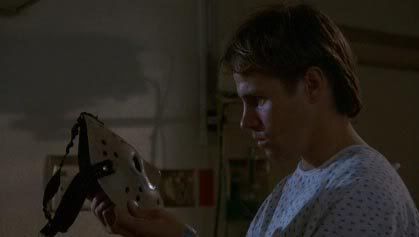
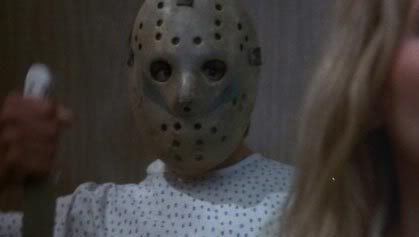
Slasher Statistics
Body Count: 23 (16 men/7 women - 3 occur in a dream sequence and one is implied but not shown)
Shower Scenes: o
Instances of Nakedity: 3 and 1/2 (Melanie Kinnaman spends the climax of the movie running around in the rain in a white shirt without a bra, which definitely counts for a half)
Obligatory Has Beens: 0 (Obilgatory never-wases on the other hand....)
Instruments of Death: Machete, ice pick, road flare, garden shears, meat cleaver, ax, leather strap, crow bar, butcher knife and iron spikes.
Creepy (and therefore suspicious ) Old Guys: 1
References to Pot: 2 (The horny guy and slutty girl smoke a joint in the woods before they have sex and get killed, and the unusually-pleasant-for-a-black-dude-named-Demon and his girlfriend also pass the dutchie on the right hand side just before he gets diarrhea and they both get killed.
Amount of Time Required to Correctly Identify Killer: Gee, I wonder why they're spending all of that screen time on that guy? Usually his role would be played by an extra without any lines. There must be something to that....
Cheesy References to Other Horror Movies: Pam picks up a chainsaw to battle the pseudo-Jason and--in a non-horror related nod to film history--two of the kids are shown watching A Place in the Sun before they get moirderized.
Utterly Pointless Trivia: The movie was co-written and directed by Danny Steinmann, the auteur responsible for the equally awful but far more awesome Linda Blair revenge vehicle Savage Streets (which currently ranks behind only Ninja III: The Domination and Skatetown USA on my Why-The-Holy-Fuck-Hasn't-This-Been-Released-As-A-Two-Disk-Special-Edition-DVD-Already? list).
Final Girl Rating: 2 out of 10
Online Slasher Movie Bonus Fun #1: Here you can download Thanksgiving, the hilarious fake slasher movie trailer directed by Eli Roth that appears in the middle of the upcoming Rodriguez/Tarantino collaboration Grindhouse.
Online Slasher Movie Bonus Fun #2: Speaking of Grindhouse, here's a podcast of Elvis Mitchell's excellent radio show "The Treatment" in which Quentin Tarantino discusses the genre and waxes rhapsodic about Carol J. Clover's brilliant book Men, Women and Chainsaws (note: you can also find and download a copy of the show on iTunes).
